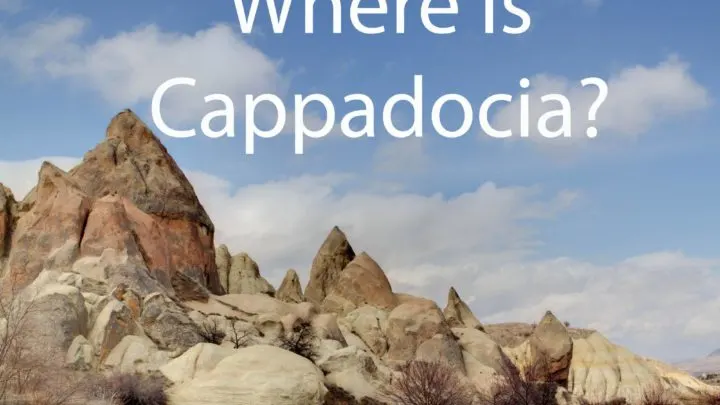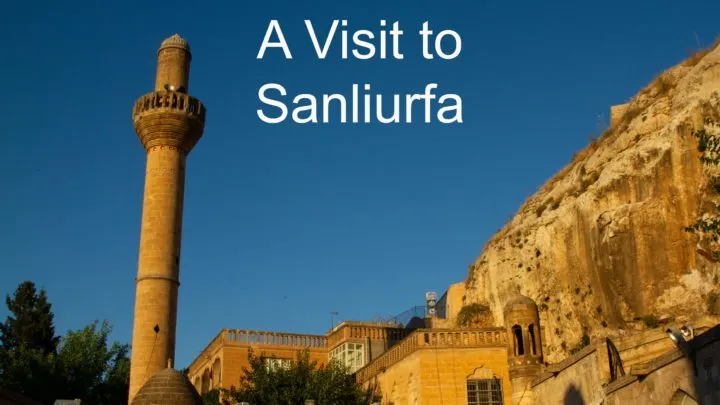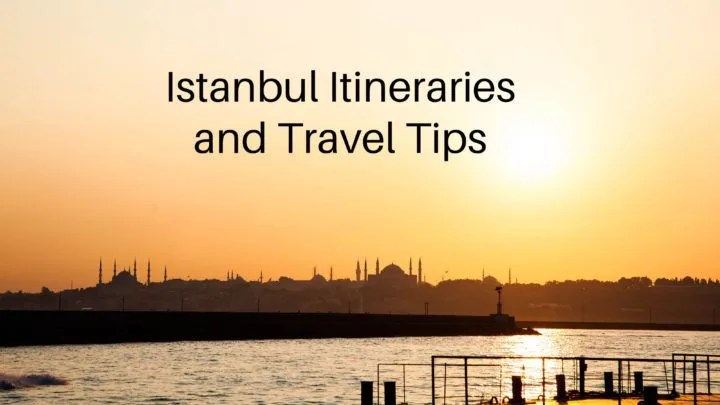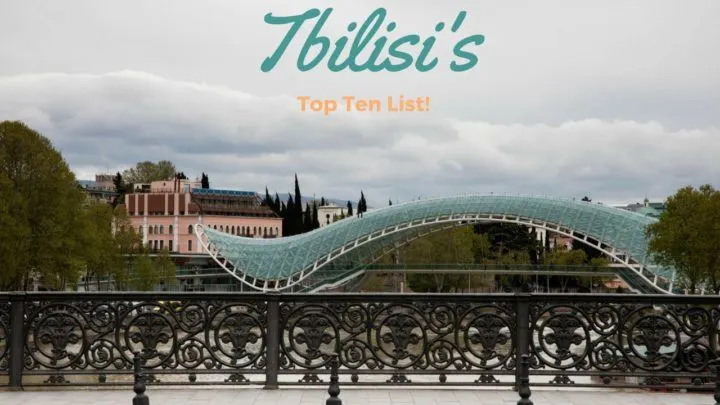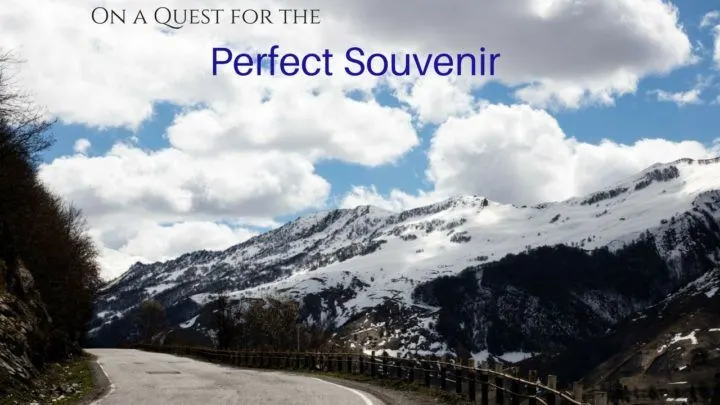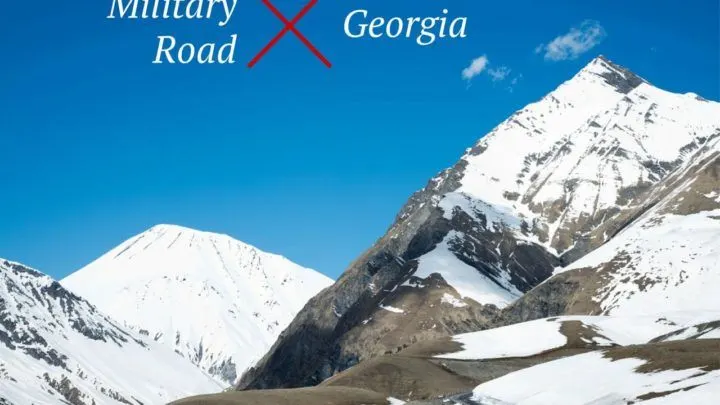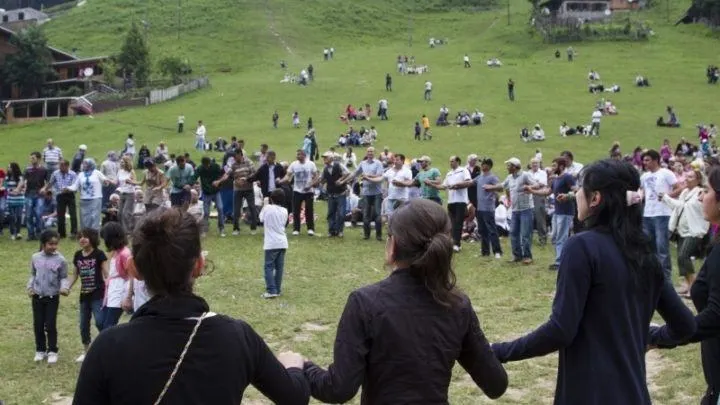Have you always wanted to explore Armenia? Among other things, it’s the first nation to accept Christianity, but it has plenty more to offer as well. In this podcast, we talk about the three days we visited this little-known country.
Or you can always subscribe to one of these:
Apple Podcasts
Google Podcasts
Spotify
Amazon Music
Show Notes
04:56 – Getting to Armenia
08:16 – Getting around in Yerevan and around the country
11:37 – Is travel to and in Armenia safe?
13:00 – Things to do in Yerevan
17:30 – Geghard Monastery
26:15 – Temple of Garni
28:05 – Lake Sevan
31:25 – Sanahin Monastery
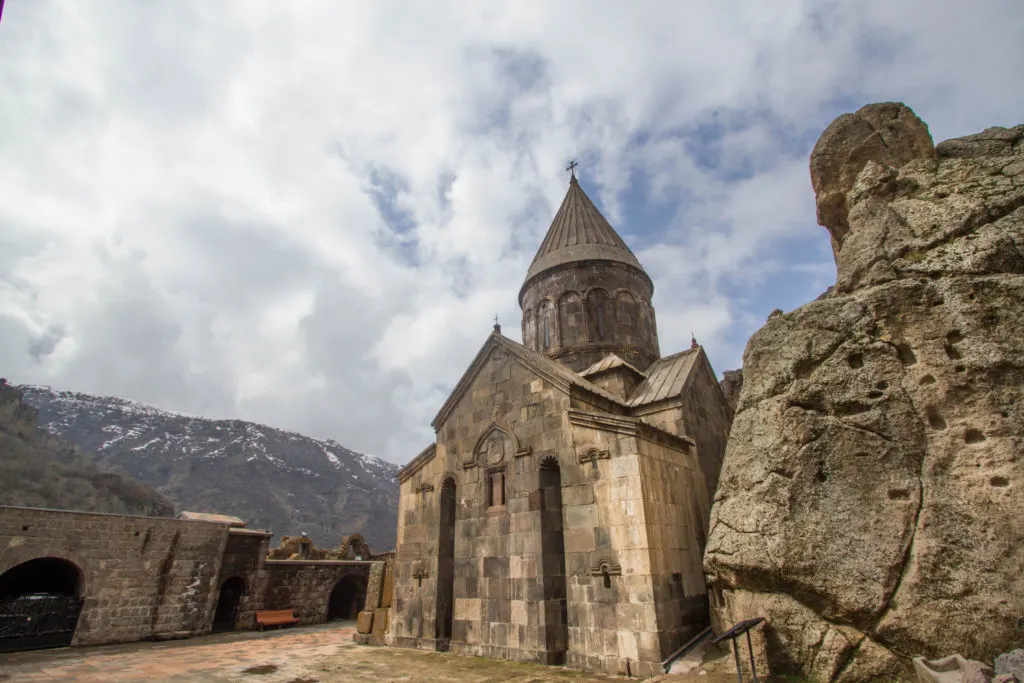
The Best Armenian Tours – Day Trips
If you want to just fly in and out of Yerevan, there’s a couple of great tours that will get you outside the city.
From Yerevan: Garni Temple & Geghard Tour with Lavash Baking is one that is a must. To be able to see and help make the lavash is something really special.
From Yerevan: Lake Sevan and Dilijan Day Tour. Lake Sevan is a must-see and the rest of the tour really shows you more about the countryside.
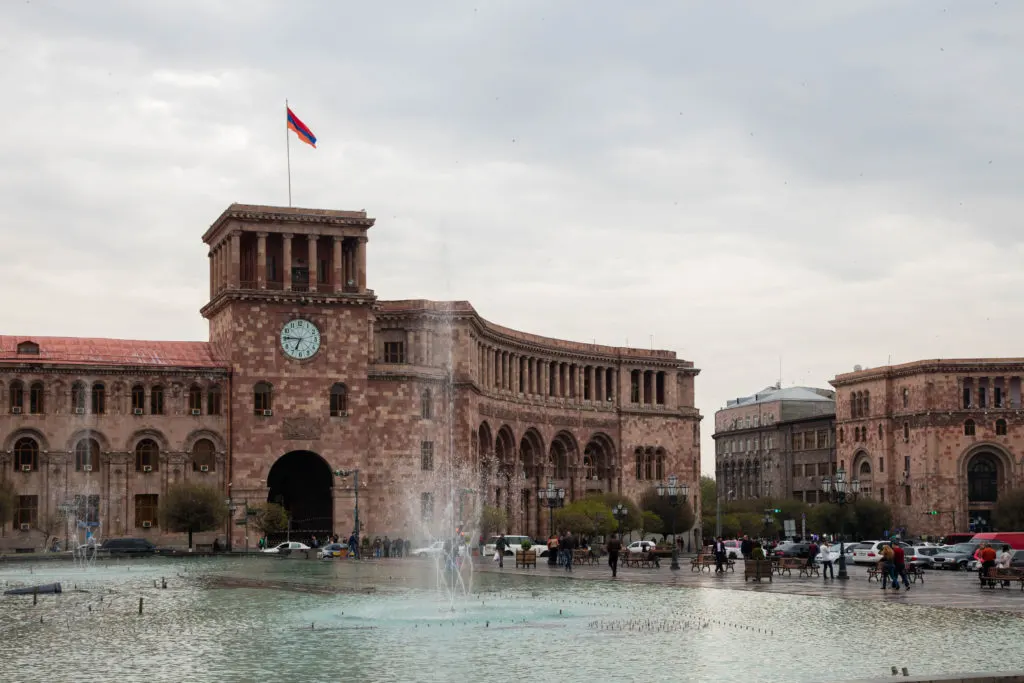
Worth Mentioning
Our articles we’ve written on Armenia:
- Top 10 Things to do in Armenia
- Start of our Armenian Road Trip (potholes!)
- Trip to Geghard and Garni
- Sanahin Monastery
- Road Trip – Rules of the Road
- Ani (Armenian ruins) in Turkey
- Akdamar Island – in Turkey with an Armenian Cathedral
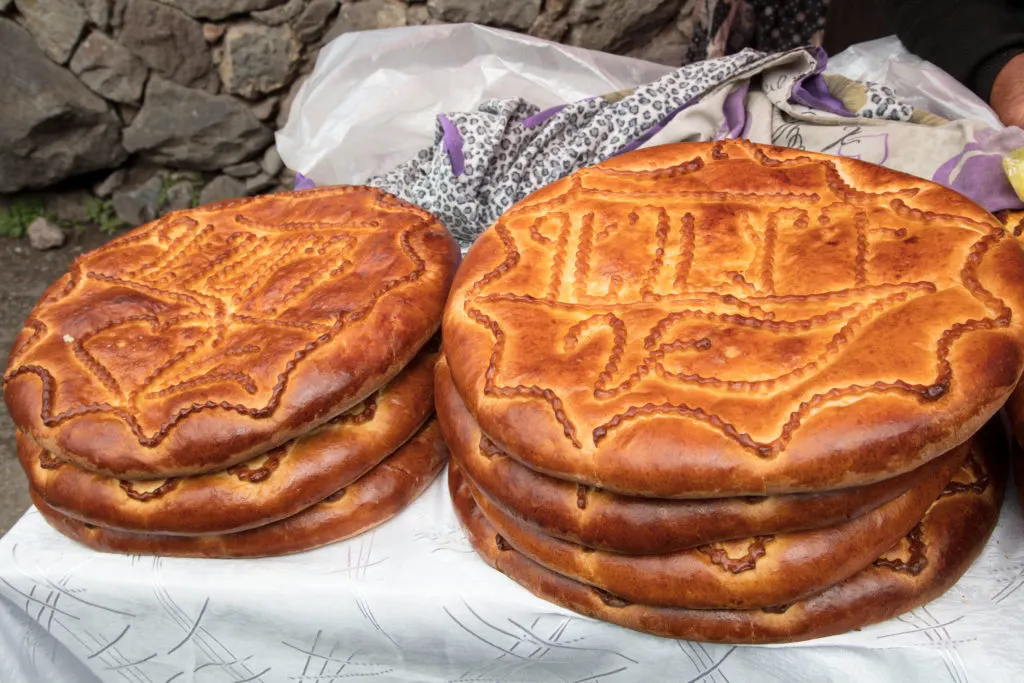
Glossary and History:
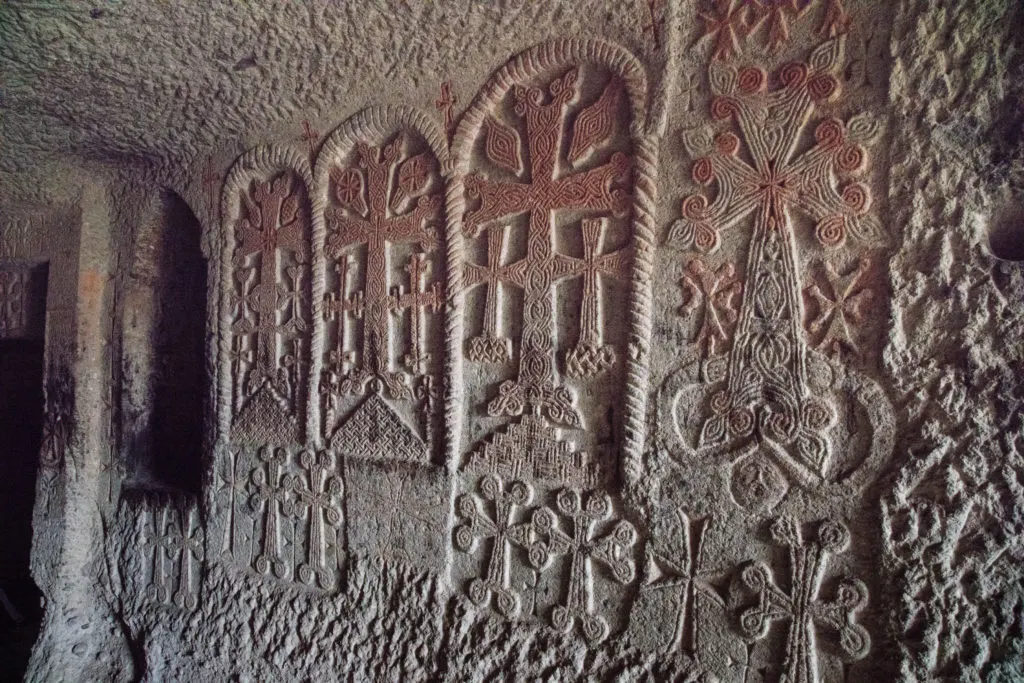
Where to Stay in Yerevan
Bass Boutique Hotel – Located in downtown, and only a ten minute walk to the Presidential Palace, the hotel has a great restaurant and comfortable vibe.
Downtown Suites Yerevan – A great place to stay if you need a little more space. Some of the suites even include a washer, which is super convenient.
Join Our Community

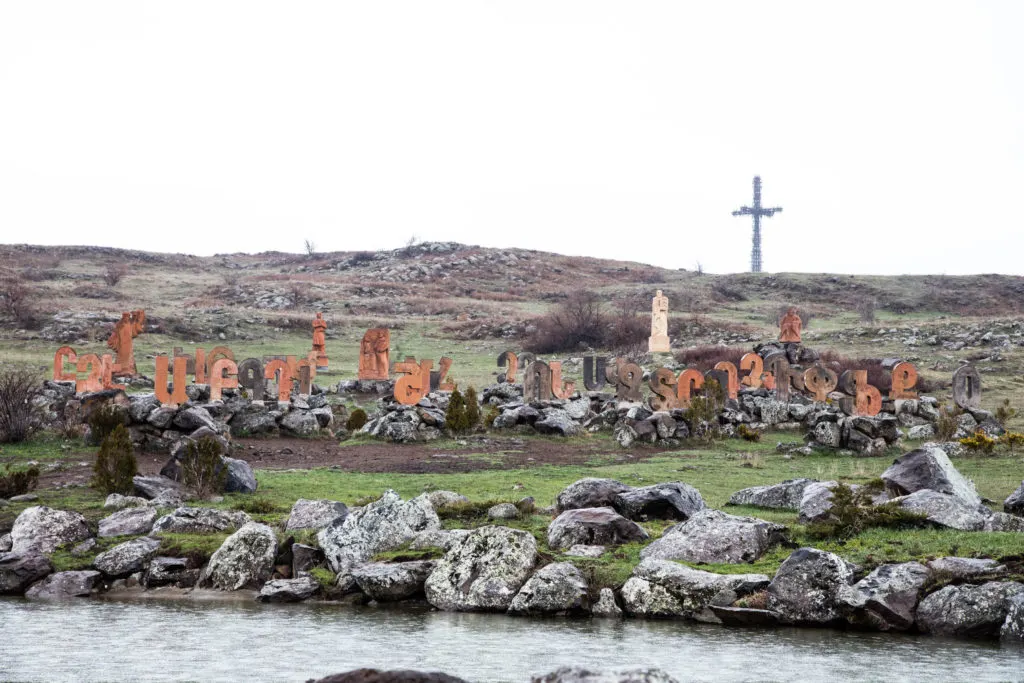
Podcaster Bios for Jim and Corinne: Jim and Corinne are a married couple who love everything travel. Having met and married in Germany, they’ve never stopped. Along the way, they have raised two kids, visited over 90 countries (including every country in Europe), and have plenty of stories and travel tips to share. Read more about them on our About page.
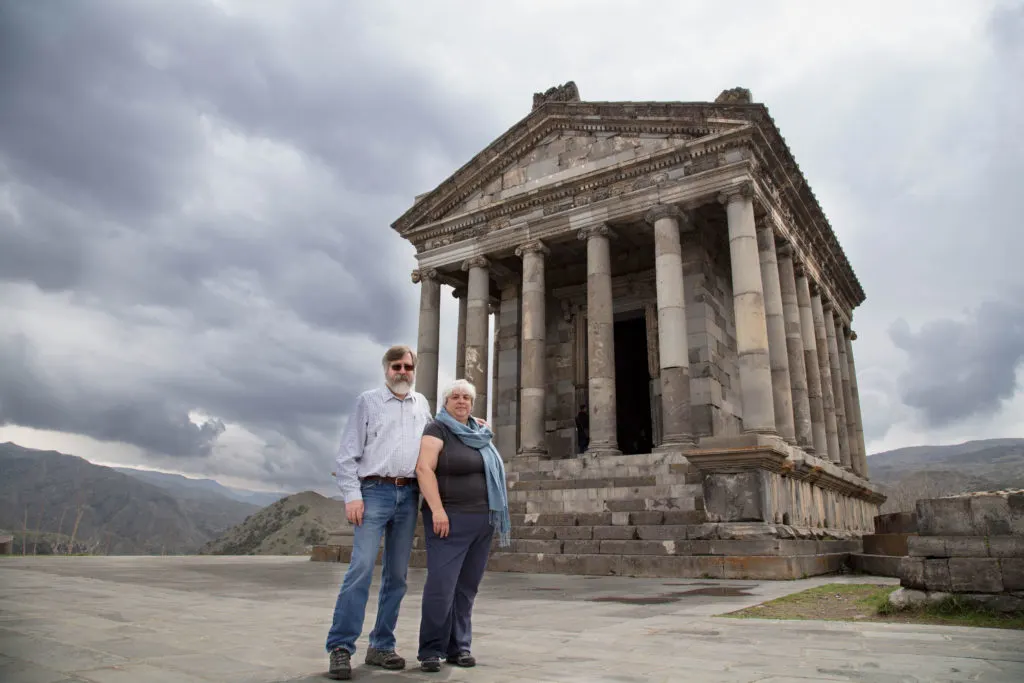
If you enjoyed our trip to Armenia...
Full Transcript of Podcast
About this transcription: We post transcripts mainly as an accessibility method. If you choose to read it, please keep in mind 1. We are people, talking, and much of it isn’t grammatically correct but works as a conversation. 2. This transcription was not done by a real person but a program, so there are probably mistakes. To really get enjoy our tips and stories, it’s just best to listen to the podcast.
Jim 0:00
Well, hello everybody. This is episode 44 of Streets and Eats. And today on the podcast we are taking you to Armenia.
Welcome to streets and eats the travel and food podcast dedicated to taking our listeners to the sights, sounds, and flavors of fascinating places near and far, both on and off the beaten path where Jim and Corinne Vail and we’ve been traveling internationally and domestically together for decades, visiting more than 90 countries in all 50 states in the USA, we’ll share all of the local knowledge and food expertise we’ve gathered through years of living as expats in Asia and Europe, as well as traveling with families spanning multiple generations around the world. Join us each week for a new adventure.
Corinne 0:40
It’s been a fun couple of weeks, we have been doing all kinds of things with the podcast and figuring out what we’re gonna do for the summer, and getting kids ready to move to Vietnam.
Jim 0:54
And I mean, I don’t think we’ve had time to breathe. And, you know, it’s been kind of a mixed blessing having the kids in the house, they’re getting ready to go to Vietnam, of course, and they’re selling their house. So we are basically two families living in one, a single-family house. And it’s kind of really turned everything upside down for us for the podcast. But because of all that, and we’ve I think we’ve done a pretty good job of pivoting as they say these days, and we no longer have our podcasting studio in the house, we had to give that up for ages. And now we’re kind of doing it more mobile,
Corinne 1:35
Which is a learning curve, but it’s something good. And something that we need to do, because I think for well, the last quarter of 2022 and quite a bit of 2023, we’ve got plans for traveling pretty long, pretty lengthy travels. So I don’t know if we’ll be gone, you know, we’re not going to be doing those two-week trips, we’re kind of over that.
Jim 2:02
On the road or, or out in the world, whether it’s on a road or an airplane or who knows what. But we need to take our podcast and our blogging and all of our stuff with us. We can’t expect to just come back for a couple of weeks and record and record and record, it just doesn’t work. And it’s more fun to do it on the road anyway. So that’s what we’re doing. And it’s working out pretty good. In the last couple of podcasts we’ve done it this way. I think it sounds pretty good. And we’ve had a lot of fun doing it.
Corinne 2:32
And it gives us some breathing room too. What’s nice, I think, it gives us the confidence to not be stuck in our little room. You know, there’s something comfort-making, you know, safe about being in this little room where no one can see you and, and see what you’re doing or hear what you’re doing. And then you can edit everything out before it happens. But our goals for our podcasts are going to be that we do it on the road. And we can even let you hear some of the sounds and beats and you know, sizzles from the places that we’re going to be. So I think this is a good first time for us.
Jim 3:12
And if you heard our interview with our friend Palle a couple of weeks back, we really got some good information from him and some good tips on equipment. So we’ve kind of updated a couple of things to give us more capabilities as far as that kind of stuff goes. So I’m really looking forward to it.
Corinne 3:30
And he’s a true digital nomad. And we’re kind of moving into the digital nomad sphere. So that kind of helped us I think it makes us feel like we’re growing. And that’s always a good thing, right?
Jim 3:43
Yeah, it really is.
Corinne 3:46
All right. So this week, we want to talk about Armenia. We went to Armenia a few years ago, and we were overwhelmed by what a friendly, fun place it was. We weren’t sure what to expect. And we went there during the spring. So, you know, we just, it was one of those places, it was kind of completely new to us.
It’s not something that we necessarily had on our radar. But we heard around and talked to a few people that had been to Georgia and Armenia in the had recently gone and told us how wonderful they were. So we planned a road trip. And we did go to both Georgia and Armenia and we already talked about Georgia already. So we wanted to make sure we got the Armenia part in there as well.
Jim 4:41
That’s right. And we did it all as a road trip, which turned out really good. We spent most of the trip in Georgia, but then a couple of days in Armenia, and that was a really good way to do it. So if you’re thinking about going to Armenia, there are a couple of ways to do it. Of course, you could fly into your Yerevan, the capital city go and rent a car or take local transportation and you can get around that way, or you take tours.. Or you can do it as part of a longer road trip and drive in from Georgia like we did. It’s pretty doable.
Corinne 5:17
And you can do it either way. I mean, you could rent the car in Yerevan and go to Georgia too. It’s not that far away. And bureaucratically, it wasn’t as hard as I expected.
Jim 5:28
No, I think the trick for doing it as a road trip where you can be crossing that border, is to make sure that you find a rental agency that has offices in both countries, because they are used to arranging the documentation, and they know what to expect at the border. And they’ll make it really smooth for you. That’s what we did, we’ll put the link to that company in the show notes. And, I mean, I can’t recommend them enough. It worked perfectly.
Corinne 5:58
But it’s not a sponsored, we’re not getting anything out of it. We’re just telling you, we had a good experience with them. And the key there was that they have offices in both countries. And I don’t think that’s unusual, to be honest, because I think a lot of people combined the two countries, and rightfully so. Yeah.
Jim 6:14
But it was difficult finding a rental agency that would do it. The big ones, the main one’s, like Hertz or Eurocar, they wouldn’t allow you cross-border travel. So it definitely takes a little bit of research. Don’t just show up thinking you can do it.
Corinne 6:27
Well, and you want to know before you go because you need to have the right paperwork, which I think was an international driver’s license.
Jim 6:35
An international license is needed to just to drive in Armenia. Whether you’re going across the border or not, you definitely need that. That’s the biggie. Of course, insurance, you know, that’s a personal choice. As far as health insurance goes, it’s always a good idea. The vehicle insurance that comes with a car, you should do as well. But there is some paperwork specific for crossing the border that the rental agency has to set up in advance. So plan that into your timing as well. If that’s the route, you’re gonna go.
Corinne 7:08
Exactly. We went in when border town and out another. And they were similar but different.
Jim 7:14
Yeah, we went in through Giguti, which was one of the main routes out of Georgia, but it’s not a trucking route. So right was actually a really good way to go. Except for the fact that the highway was going through some major construction for about 20 kilometers where it was almost like off-road driving. But it wasn’t too bad. And then when we did get to that border, it was I mean, it was empty. It didn’t take any time at all. But coming back through the Bagratashen, I think it’s called. That is the major trucking route through. And it was quite an interesting experience. It didn’t take much longer. But it was definitely a lot more going on there.
Corinne 8:01
A lot more scrutinizing us. Yeah. Not in a bad way. They just want to make sure they’re doing their job; we get it.
Jim 8:08
So once you get to Armenia and Yerevan, getting around the city itself is really easy. There’s a metro system, there’s a bus system, taxis are super cheap, two or $3, pretty much to get from one point to another easily.
Of course, you know, with apps these days, there are apps you can use to call your taxi, we didn’t find a lot of English speaking in Armenia, and we also didn’t have any trouble getting around ever had ended up getting round. So things like the apps can really help you.
Google Translate, of course, is everybody’s friend when it comes to traveling and places like that. But it’s pretty easy to get around the city, getting out of the city because this tax is so cheap. If you’re doing day trips in and out of your Yerevan, you could easily get a taxi for the day, just negotiate it upfront, offer 20 $30 for a day, and they’ll drive you to the places you need to go, and they’ll wait for you. That’s a really good way to do it. There are a lot of really good tours that you can take that you can arrange for your hotel. We’ll put, some links in our show notes for those.
Corinne 9:14
And there are lots to do. We spent one full day in Yerevan and then the rest of the time going out and doing day trips. We stayed in the same hotel the whole time I think. The day trips in and out of the city, like Jim said, is easy because it’s a small country. It’s pretty easy to get around.
Although the roads can be very, very rough. Now, we must have spent at least one night we did at Lake Savan because we went up to the monasteries and that’s quite a waste of your time. Yeah. So we didn’t spend every night in Yerevan, but most of the nights we did anyway. The roads can be pot-holy.
Jim 9:50
But the potholes ranged from, you know, a minor pothole like you would experience pretty much anywhere in the world except for maybe Germany. I never found a pothole there, but they could be so big it’s hard to get your car out of them.
Corinne 10:06
But the signage was pretty easy to follow. I think. In fact, maybe everything was in English that we wanted to do. So there was always some sign pointing us in the right direction. We had paper maps. We did not use Google that much.
Jim 10:23
No, but maps dot me, I think I always mentioned when we’re talking about getting around because you can download the entire map and database for a country or a region and have it with you whether you have data or not. So that’s always a good idea. I think we use maps.me A little bit, but it’s super easy to navigate around. And there are not a whole lot of problems getting around the country.
Corinne 10:47
Well, and that was one of the things that I enjoyed about our rental agency, too. I basically told them what our agendas were and what we wanted to see. And, they kind of mapped it out for us.
And they said, Okay, we’ll go here, here, here, here and here. And then they gave us the maps to show us how to do it. Yeah, it was really nice. Maybe we spent a little bit too much time there the first day, but that’s okay. It worked out in the long run. So getting the car. Yeah, that’s okay. It took a little time. Just plan that in.
Jim 11:13
And the other thing to remember if you are going to be driving across the borders is to have some cash with you at the borders because there are some things you have to pay for in cash at the borders. So dollars, euros, or local currency.
Corinne 11:29
Okay, so I think one of the things that people would worry about is Armenia safe? It was just as safe, just like anywhere else. I mean, you don’t want to traipse around in the middle of the night by yourself. Always be with someone; always be vigilant.
I mean, at the most you’re going to, you know, run into someone who is not so well off, and maybe, you know, your flashy camera looks like something they could make money on. But that’s true all over the world. So it’s just I would say it’s one of the safer places, you just want to make sure that you’re always aware.
Jim 12:03
Well, you also have to remember that Armenia and Azerbaijan have been at war off and on for the last few decades. Right now. There’s a there’s been a peace treaty signed. But even still, there’s been some violence along the borders.
At the time that we went in. They were actively at war. And people told us, oh, you’re going to Armenia but they’re at war with Azerbaijan. But when we were getting the rental car, and when we talked to other people that had done the trip, everybody said, Yes, it’s true, there is hostility is taking place in certain regions. But it has never spilled out of those regions. And as long as you stay out of those regions, you’ll never even know what’s going on. And we didn’t, then that’s exactly what we found.
Corinne 12:47
We didn’t; we didn’t run into anything at all. So we have a whole post on things to do in Yerevan. But some of our favorite things was to go down to President’s or Republic Square, where we went in the evening, and they have these, you know, fun little fountains, and everybody’s walking around with their kids. And they’re playing catch, and it’s just a place for people to go. And, you know, catch up on the gossip and, and have fun. So that was really, that was very cultural. And, and I really enjoyed it. It was a beautiful night, the sunset was pretty. And of course, all the restaurants are around that area, too. So we walked around as the sun was setting, and then we went to eat.
Jim 13:30
Yerevan is also known as the Pink City, because of all the pink stones they used to build during the Soviet era to build these massive buildings. Actually, for Soviet architecture. I think it’s quite, quite beautiful. What they’ve done in Armenia, it’s beautiful. And when the sun sets, it really brings out the color in that stone. And it’s just gorgeous.
Corinne 13:55
That was, that was kind of nice. That was one of the very first things we did before we went to dinner on the first day. And then the next day, we did, you know, a couple of museums and things like that.
Jim 14:05
The Opera and Ballet Theatre, I think were really beautiful. We didn’t get a chance to attend an event while we were there. But I would love to do that. It’s supposed to be just as beautiful inside as it is outside. In that whole Yerevan area, that downtown area was just fun to walk around and do some interesting shopping. If you’re into that sort of thing. Good souvenirs, lots of cafes, and just a great place to hang out.
Corinne 14:33
I think it was very Soviet in a lot of ways. I mean, it’s one of the most Soviet feeling places we’ve been to. It wasn’t the most, because I would give that to Belarus. But definitely close to one of the most Soviet places that we’ve been, including Russia.
Jim 14:51
Also right off Republic Square is the National Gallery and the history museum, which are both really good places to go and see some of the history and culture of Armenia. Yeah, if you’re not really familiar with it, it’s a great way to spend an hour, maybe two hours just familiarizing yourself with the history of the country, and seeing some of the artwork.
Corinne 15:11
I think my absolute favorite thing, though, was as you’re driving out of the city, you come across a monument to the Armenian alphabet. And it’s this piece of ground that just has all the letters. They look haphazard to me. I don’t think they say anything. You think it’s just the alphabet? Armenia, so we don’t know. But it’s just a lot of fun. And it’s like this rusted metal structure. And you could walk around them. And although there are not more about them, they were very Instagrammy.
Jim 15:45
Instagrammy for sure. Oh, the other thing in Yerevan that I really thought was unique and pretty cool, was the cascade complex, which was kind of a little bit before or maybe on the edge of the old town area, where they had built into the side of the hill, this massive staircase structure, waterfall, splash fountain slash garden area, which also housed an art museum as well.
Corinne 16:14
And it’s also a mall too. There are lots of restaurants and cafes right in the area. It’s definitely a place you don’t want to miss because it’s just sort of where everything’s happening. Yerevan’s a small city, but it is the capital.
There are a million people in it. And it feels kind of like a small town. You can go shopping, you can walk around the streets, and everyone’s friendly. We were there in the spring, and it was raining pretty much the whole time we were near Yerevan. And it didn’t seem to dampen their spirit. Not at all.
Jim 16:44
You know, it’s also, which was surprising to me. I didn’t you wouldn’t know this being there. It’s also one of the oldest cities on earth that’s been continuously inhabited. 2800 years old. But there’s not whether because of the Soviets or earthquakes or who knows. There’s not a whole lot of that ancient structures still standing, unfortunately.
Corinne 17:06
So one of the things that we wanted to do when we were in Armenia was to visit the UNESCO World Heritage Sites. And there was more than I was expecting. It’s a small country, and yet there are quite a few things to go see. A lot of them revolve around Christianity because it was a nation that adopted Christinity early on! And they are very proud of that fact.
Jim 17:31
Okay, leaving Yerevan and going out on our first-day trip, we went out to the Gebhard Monastery and the Temple of Garni.
Corinne 17:38
Which, if you’re going to Yerevan, you’re going to go to Geghard and Garni. They’re on the same road. They’re not far from Yerevan. And it’s given that you’re gonna go here. And so we did. And to be honest, we were gobsmacked. Yeah, the Geghard monastery was amazing.
Jim 17:57
Well, the monastery of Geghard began to emerge right out of the living rock in the fourth century. It is really old. Of course, it outgrew those caverns pretty quickly. And so by the 12th century, they’d already built a small church, a little cathedral. It’s just an incredible place, though, and it’s tucked up in this valley. And during the spring, the flowers were starting to come out the trees were all budding. It was just gorgeous.
Corinne 18:26
It was really pretty. And like he said, I mean, first it was in the caverns, and then it was in this cathedral-type building, which itself is beautiful. And of course, for us, it was the first place that we saw the kachkar crosses, which are very unique just to Armenian Christianity. And they’re beautiful. And everything’s built right into the rock. So we had a fantastic time going around and seeing all the different things at the monastery, which is a very small area, but it was packed full of stuff. But then something really amazing happened.
Jim 19:01
Yeah, as we are walking in this small group of women dressed in these really ornately decorated long robes
Corinne 19:10
With pomegranates on them all around.
Jim 19:16
We thought it was pretty cool. They were all hand embroidered, and just beautiful. They were pretty. Anyway, they walked through the monastery and we saw them walking in and thought well, that’s interesting. They obviously weren’t a tour group, right? We didn’t know what they were doing.
But I think we got a little bit sidetracked going up into the gardens and checking out the beehives is a lot of fun, just really exploring the whole place. And I think at one point we got separated. And I found myself in one area. And I could hear like this really mystical magical music just permeating through everything. And it ended up being In the group of women was a small chorus. And they had found the one spot in the monastery where they could sing, and it just carries throughout the entire complex.
Corinne 20:15
It was amazing and is one of the most beautiful things I’ve ever heard.
Jim 20:19
Yeah, it was incredible. There was a small little group of tourists there that were on a group tour. And it felt really bad for them because they were there before us. And as the women were walking in to set up to go sing, they were clearly at the end of their tour, about time to leave. And right as the women started singing, was it the exact moment that the tour group guide decided was the time to leave. So there was a little pause in the singing. And you could clearly hear him say, okay, that wraps up our time here. Now it’s time to move on. And we’ll be going to the temple of Garni.
Next, you can see the faces of the different tourists in the group going, we can’t leave now. They’re just starting to sing. Yeah. But luckily, we weren’t in that tour group. No, we had our own car, which is why we love to have our own car. So we have a little bit more of our own time. We were able to sit there and just be mesmerized by this for a good 20-30 minutes.
Corinne 21:25
We have no idea. I mean, we assume they could have been religious songs. I mean, it was in a holy place. So but we have no idea what it was. And we don’t speak Armenian. But we do know good music when we hear it, and it was beautiful. And it was all acapella. It was just gorgeous.
And in fact, I think Jim recorded some of it. And we’ll put a little bit of a clip-on there. So you can hear it. But it was amazing. And we really enjoyed it. The whole monastery was more than we expected. And then it’s probably the most visited thing in all of Armenia.
Yeah, outside of YerevanI’m sure. Because they had, just like I used to love it in Turkey, they had a couple of local vendors, hawking their wares, their handmade stuff right outside in the parking lot, and we can’t pass those up. Because those aren’t local businesses where these people, you know, are making tons of money. These are women who in between their hand washing and their baby rearing and their food-collecting and their food making and whatever else they have to do, they set aside a little bit of time each day to make a little extra food or crochet some beautiful doilies, or make knitted socks. And they make pennies. I mean, just pennies. So I can’t I can’t pass them by and it’s a good way to support the local community. I think it provides goodwill, but it’s just, that it’s also so cultural.
Jim 22:59
And you have a hard time passing by a pair of hand-knitted socks anywhere.
Corinne 23:05
Yeah. Yeah, those are a downfall. I have tons of them. Too many. I wouldn’t say too many.
Jim 23:11
I think in a way, it was different than a lot of tourist sites around the world where a lot of what they have in the stalls but the wares were probably made in China or Indonesia or somewhere else, not there.
Corinne 23:31
So you’re talking about the gauntlet that you have to go through whether you’re in Pisco or if you’re in the pyramids, if you’re at the Great Wall, but those things that’s what I’m saying. Those are businesses, those are people who have bought their stock another way.
Jim 23:50
They’ve bought souvenirs to sell. Yeah, so these are people’s wares are hand-made. Yeah, food, food items. home-canned food, preserves, that sort of thing. Yeah, we always support that stuff.
Corinne 24:06
Always 100%. So on this particular one, we bought two things, both food items. I don’t think we bought any socks, not until later. And one was called gata. And it was this buttery, honey type of cake that I had read about that you should try when you’re in Armenia, but I was like, how are we going to find this unless we couldn’t happen to be lucky at a bakery or something? And the top of the gata was so richly decorated. It was beautiful. And luckily, it was huge. Yeah. And we’re talking to the vendor and we’re like, oh, no, I’m want to buy it, but I also didn’t want to throw it away.
Jim 24:45
You know, the cakes were what two feet across? Huge in diameter. Way too big for two people.
Corinne 24:52
Luckily, she gave us a taste. It was delicious. We decided we definitely were gonna support her. And she’s kind of sold us just a quarter of it. She would cut off pieces, which was nice. And then the other thing we had we actually learned to make
Jim 25:08
in Georgia in Georgia churchkela.
Corinne 25:10
Basically what it is, is a, like a, like a fruit roll up with walnuts in it. And it’s delicious. Yeah, it’s really all homemade. And we’ve had it. Well, we had it in Turkey, and we had it in Georgia. And we also, of course, had some in, in Armenia.
Jim 25:27
So Geghard was one of those places, the serenity of it, the peacefulness, just, it just surrounds you. And it’s such a calming place. So leaving there was kind of hard and you really wanted to spend more time there, but we had to get going.
Corinne 25:45
And we’d seen it. But it was just we were enjoying taking pictures. Like everything about it made us feel great to be a traveler. But you know, sometimes you’re on a time clock, and we needed to get to that Temple of Garni.
Jim 25:57
Yeah. And actually driving out of your Yerevan, you’re going down the same road to the Temple of Garni and to Geghard monastery, In fact, Geghard was at the very end of the road. So we kind of went back and forth, should we be going to drive right by Temple of Garni, we’d stop there first and then go to Geghard?
And our thought process going into it was, well Geghard’s at the end of the road, if we can get there first. We’re getting there earlier than a lot of other people might get there. And it’s always better to be earlier at someplace before the crowds.
So it worked out for us perfectly. Exactly right. That’s so that’s what we did. There was that one small tour that was there before us. But they left and actually once they left, there was nobody else there. Which was really nice.
And then as we got to Garni there were definitely more people it was a little bit later in the day. I wouldn’t say it was crowded. We never had any crowds anywhere in Armenia, which was nice. But there were certainly a few different tour groups there. And of course, individuals that were there were walking the grounds as well.
Corinne 27:01
And again, it was spring and the cherry blossoms were out. It was a beautiful place. It really was. But it was kind of. I don’t know, kind of a letdown After Geghard.
We had such good feelings about Geghard and what an amazing sight it was to see that when we got to the Temple of Garni which is completely different. I mean, it’s a temple, it looks like a temple.
Jim 27:24
A Grecian temple, or a Roman temple, perched on the top of a plateau overlooking a cliff that goes down into a deep valley. It’s a beautiful location. We certainly had a good time, just wandering the grounds and enjoying the weather is beautiful.
Corinne 27:43
And it was also a place where they’re expected more tourists for some reason, or they expected people to hang out there. Because there were a lot more restaurants right in the area around there. Whereas there was nothing really at Geghard. That’s right. It was kind of interesting.
Jim 28:00
And I thought at first I thought, well, maybe a lot of people don’t go on to Geghard. But a lot of the tour groups that were leaving Garni were going to Geghard next. I don’t know.
Corinne 28:11
I think we just picked the right way. We got lucky it worked out really well. So I would say that’s a given that you’re gonna get a Geghard and Garni, and you’re going to enjoy them. And the other thing we did is we needed to go to Lake Savan.
We also wanted to go to the other UNESCO world heritage sites which were a couple of monasteries up the road. And so we did check out of our hotel at Lake Savan, which is one of the places that you’re supposed to see when you’re in Armenia.
Although, I don’t think when they said that they were really thinking spring weather, because it was pretty deserted. There were a couple of restaurants and we definitely got a hotel room and it was okay. I mean, there was nothing wrong with being there at that time. It just wasn’t the kind of summer jaunty you know, life on the lake that I think they really wanted to project.
Jim 29:03
I think that yeah, lakeside town is what it’s all about, and it’s more summer. So it was almost deserted when we were there.
Corinne 29:09
One of the things that really stuck out to me though, is one of the UNESCO intangible things in Armenia is the making of lavash, which is a flatbread and they do it in a tandoori oven. And we were racking our brains how we were gonna see this, and we just happened upon a place that was making bread and right around Lake Savan.
And it was so fun and interesting to watch this guy. Basically, he was practically jumping in the oven to pat the dough on the side of the oven, and it was so deep. It was massive. And it was hard.
I mean, I don’t know how many degrees but you figure it was probably around, I don’t know? 500 degrees, I don’t know. Because basically, you get your dough after it’s formed into a ball and you pat it, you shape it, and you plop it on the inside of the oven, and then you take it out again. I don’t know how he did it. Yeah, it was pretty amazing to watch.
Jim 30:08
It’s a lot like a just a massive tandoori, a Tandoor oven. Right. Where it’s a pit oven made of clay. I think a person could easily stand up inside of the ones we saw.
Corinne 30:21
They were huge, much larger than I expected, much larger than you would think. So anyway, that was pretty cool. So we saw it at Lake Savan. And we basically just spent the night there and had a nice dinner. And like I said, we got lucky to see the bread being baked. Then we went up the road to see even more monasteries.
Jim 30:41
Well, we got really lucky because driving around, we did not find a lot of restaurants or rest areas where you can stop and get food. I think that’s the only one we saw on any of the major highways.
Corinne 30:55
W
We didn’t have trouble getting food either. I mean, there were a couple of places we stopped at grocery shops. It seems like we get to a town there didn’t seem to be a whole lot of activity yet, things were open. It was just I don’t know if it’s because it was raining or, and spring weather, I don’t know. But I think probably at different times of the day there would be more people about than what we seemed to see.
Jim 31:18
So outside of Yerevan, we did get to another UNESCO World Heritage Site this on a Sanahin monastery, which was, I think, completely different than Geghard. Geghard was more like in a natural setting, originally was built in caves, as we said. And they really had kept that I think that connection to nature throughout the centuries.
Whereas in Sanahin, I didn’t really get that same feeling. It was more of a structured, well-built monastery. But what was really fascinating there were all the tombstones on the floor and all the carvings, right that were made out of stone.
Corinne 31:59
There are lots of monasteries and churches that are made out of stone, but they’re all…so chiseled. And so you know, specifically, these were all kind of rundown, the edges were rounded, you could see the ancient-ness in them. It was just really cool. It wasn’t well lit. So it made you feel like you were sort of walking back into time. And it just gives you this feeling of continuity. I guess, from a long time ago, it definitely felt ancient, in a different way than other ones we’d been to.
Jim 32:36
It connected you to history, which I really enjoyed. Yeah, again, not very crowded, not touristy at all.
Corinne 32:42
There was only one other group when we were there. It was just a little van full of German tourists who had a guide. So they were, you know, they’d be out in the middle of the courtyard, and they’d be telling them stories and we’d be wandering through. So that worked well for us because they were easy to avoid them which is great when you’re taking photos, and for me, I like doing things on my own.
Jim 33:04
Especially in a monastery or something like that, where it’s more about the solitude and the silence. Yeah. Unless there happens to be a choir singing somewhere. Exactly. Which you can’t get that lucky too many times.
Corinne 33:17
Well, it’s only happened to us once in our traveling lifetime. Overall, we spent probably about three full days in Armenia. And we really enjoyed our time. And as we were leaving, I think we discussed that we probably should have spent maybe another two days there, there were a couple of other places that we didn’t get to that we would have liked to get to.
But you know, you have to make choices when you’re planning and we had only planned three days. But in our three days, I think we did a pretty good job, getting a good feel for the country. Talking to people, enjoying the food. The food was really good everywhere we went and we got to see some really cultural icons.
Jim 34:03
And because we were driving ourselves, we really got to explore it. The time that we were in the country, we were in the countryside driving through villages. I think you’re right. I think five days would be a lot better. Yeah, in five days you could get out to Mount Ararat and towards the Turkish border and that’s a really beautiful part of the country.
Corinne 34:25
And I also think that spring was a little chilly, a little bit rainy. I think it would be better if we weren’t there in April, but I’m sure by May it would have been beautiful weather. So I would think it would be a little bit better to go in late spring or summer.
Jim 34:42
May or June and maybe September or October Yeah, I think it would get very hot again in July and August. April was just a little too challenging. And like you said Lake Savan was not really open for business.
Corinne 34:57
Yeah, but if you get a chance to get to Armenia, whether or not it’s on a business trip or not, And if you’re traveling in the Caucasus, the mountains are beautiful. The people are amazing. And we just really enjoyed ourselves. So take advantage of your time. Make sure that if it’s a business trip, you plan a couple of extra business days. I mean extra free days on the end, one end of the other, and get to know the country you’re in.
Jim 35:30
Alright, thanks for listening to this episode o Streets and Wats. If you liked what you heard, please show us some love. Hit the like button and leave us a review. Maybe even subscribe so you don’t miss any future podcasts. Also, we’d love it if you joined us on our Facebook private group streets needs where we just have an ongoing conversation about all things travel. Ciao for now.
Transcribed by https://otter.ai

